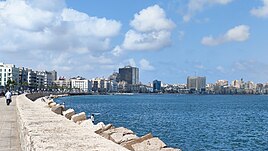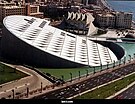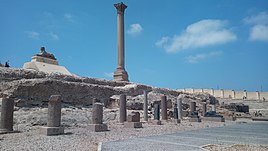
A | B | C | D | E | F | G | H | CH | I | J | K | L | M | N | O | P | Q | R | S | T | U | V | W | X | Y | Z | 0 | 1 | 2 | 3 | 4 | 5 | 6 | 7 | 8 | 9
Alexandria
الإسكندرية (Arabic)
Αλεξάνδρεια (Greek)
| |||||||||
|---|---|---|---|---|---|---|---|---|---|
View of the Waterfront Stanley Bridge | |||||||||
| Nicknames: Mediterranean's Bride, Pearl of the Mediterranean, Aleks | |||||||||
| Coordinates: 31°11′51″N 29°53′33″E / 31.19750°N 29.89250°E | |||||||||
| Country | Egypt | ||||||||
| Governorate | Alexandria | ||||||||
| Founded | 331 BC | ||||||||
| Founded by | Alexander the Great | ||||||||
| Government | |||||||||
| • Governor | Mohamed Taher El-Sherif[2][3] | ||||||||
| Area | |||||||||
| • Total | 1,661 km2 (641 sq mi) | ||||||||
| Elevation | 5 m (16 ft) | ||||||||
| Population (2023) | |||||||||
| • Total | 6,100,000[1] | ||||||||
| Demonyms | Alexandrian, Alexandrine (Arabic: إسكندراني) | ||||||||
| GDP | |||||||||
| • Metro | EGP 566 billion (US$ 36 billion) | ||||||||
| Time zone | UTC+2 (EGY) | ||||||||
| • Summer (DST) | UTC+3 | ||||||||
| Postal code | 21xxx | ||||||||
| Area code | (+20) 3 | ||||||||
| Website | alexandria.gov.eg | ||||||||
Alexandria (/ˌælɪɡˈzændriə, -ˈzɑːn-/ AL-ig-ZA(H)N-dree-ə;[5] Arabic: الإسكندرية;[a] Greek: Ἀλεξάνδρεια[b], Coptic: Ⲣⲁⲕⲟϯ - Rakoti or ⲁⲗⲉⲝⲁⲛⲇⲣⲓⲁ) is the second largest city in Egypt and the largest city on the Mediterranean coast. It lies at the western edge of the Nile River delta. Founded in c. 331 BC by Alexander the Great,[9] Alexandria grew rapidly and became a major centre of Hellenic civilization, eventually replacing Memphis, in present-day Greater Cairo, as Egypt's capital. Called the "Bride of the Mediterranean" internationally,[10] Alexandria is a popular tourist destination and an important industrial centre due to its natural gas and oil pipelines from Suez.
The city extends about 40 km (25 mi) along the northern coast of Egypt and is the largest city on the Mediterranean, the second-largest in Egypt (after Cairo), the fourth-largest city in the Arab world, the ninth-largest city in Africa, and the ninth-largest urban area in Africa.
The city was founded originally in the vicinity of an Egyptian settlement named Rhacotis (that became the Egyptian quarter of the city). Alexandria grew rapidly, becoming a major centre of Hellenic civilisation and replacing Memphis as Egypt's capital during the reign of the Ptolemaic pharaohs who succeeded Alexander. It retained this status for almost a millennium, through the period of Roman and Eastern Roman rule until the Muslim conquest of Egypt in 641 AD, when a new capital was founded at Fustat (later absorbed into Cairo).
Alexandria was best known for the Lighthouse of Alexandria (Pharos), one of the Seven Wonders of the Ancient World; its Great Library, the largest in the ancient world; and the Catacombs of Kom El Shoqafa, one of the Seven Wonders of the Middle Ages. Alexandria was the intellectual and cultural centre of the ancient Mediterranean for much of the Hellenistic age and late antiquity.[9] It was at one time the largest city in the ancient world before being eventually overtaken by Rome.
The city was a major centre of early Christianity and was the centre of the Patriarchate of Alexandria, which was one of the major centres of Christianity in the Eastern Roman Empire. In the modern world, the Coptic Orthodox Church and the Greek Orthodox Church of Alexandria both lay claim to this ancient heritage. By 641, the city had already been largely plundered and lost its significance before re-emerging in the modern era.[11] From the late 18th century, Alexandria became a major centre of the international shipping industry and one of the most important trading centres in the world, both because it profited from the easy overland connection between the Mediterranean and Red Seas and the lucrative trade in Egyptian cotton.
History
Ancient era
Radiocarbon dating of seashell fragments and lead contamination show human activity at the location during the period of the Old Kingdom (27th–21st centuries BC) and again in the period 1000–800 BC, followed by the absence of activity after that.[12] From ancient sources it is known there existed a trading post at this location during the time of Rameses the Great for trade with Crete, but it had long been lost by the time of Alexander's arrival.[9] A small Egyptian fishing village named Rhakotis (Egyptian: rꜥ-qdy.t, 'That which is built up') existed since the 13th century BC in the vicinity and eventually grew into the Egyptian quarter of the city.[9] Just east of Alexandria (where Abu Qir Bay is now), there were in ancient times marshland and several islands. As early as the 7th century BC, there existed important port cities of Canopus and Heracleion. The latter was recently rediscovered underwater.
Alexandria was founded by Alexander the Great in April 331 BC as Ἀλεξάνδρεια (Alexandreia), as one of his many city foundations. After he captured the Egyptian Satrapy from the Persians, Alexander wanted to build a large Greek city on Egypt's coast that would bear his name. He chose the site of Alexandria, envisioning the building of a causeway to the nearby island of Pharos that would generate two great natural harbours.[9] Alexandria was intended to supersede the older Greek colony of Naucratis as a Hellenistic centre in Egypt and to be the link between Greece and the rich Nile valley. A few months after the foundation, Alexander left Egypt and never returned to the city during his life.
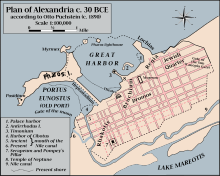
After Alexander's departure, his viceroy Cleomenes continued the expansion. The architect Dinocrates of Rhodes designed the city, using a Hippodamian grid plan. Following Alexander's death in 323 BC, his general Ptolemy Lagides took possession of Egypt and brought Alexander's body to Egypt with him.[13] Ptolemy at first ruled from the old Egyptian capital of Memphis. In 322/321 BC he had Cleomenes executed. Finally, in 305 BC, Ptolemy declared himself Pharaoh as Ptolemy I Soter ("Savior") and moved his capital to Alexandria.
| ||||
| r-ꜥ-qd(y)t (Alexandria)[14][15] in hieroglyphs | ||||
|---|---|---|---|---|
Although Cleomenes was mainly in charge of overseeing Alexandria's early development, the Heptastadion and the mainland quarters seem to have been primarily Ptolemaic work. Inheriting the trade of ruined Tyre and becoming the centre of the new commerce between Europe and the Arabian and Indian East, the city grew in less than a generation to be larger than Carthage. In one century, Alexandria had become the largest city in the world and, for some centuries more, was second only to Rome. It became Egypt's main Greek city, with Greek people from diverse backgrounds.[16]
The Septuagint, a Greek version of the Tanakh, was produced there. The early Ptolemies kept it in order and fostered the development of its museum into the leading Hellenistic centre of learning (Library of Alexandria, which faced destruction during Caesar's siege of Alexandria in 47 BC), but were careful to maintain the distinction of its population's three largest ethnicities: Greek, Egyptian and Jewish.[17] By the time of Augustus, the city grid encompassed an area of 10 km2 (3.9 sq mi),[18] and the total population during the Roman principate was around 500,000–600,000, which would wax and wane in the course of the next four centuries under Roman rule.[19]
According to Philo of Alexandria, in the year 38 AD, disturbances erupted between Jews and Greek citizens of Alexandria during a visit paid by King Agrippa I to Alexandria, principally over the respect paid by the Herodian nation to the Roman emperor, which quickly escalated to open affronts and violence between the two ethnic groups and the desecration of Alexandrian synagogues. This event has been called the Alexandrian pogroms. The violence was quelled after Caligula intervened and had the Roman governor, Flaccus, removed from the city.[20]

In 115 AD, large parts of Alexandria were destroyed during the Kitos War, which gave Hadrian and his architect, Decriannus, an opportunity to rebuild it. In 215 AD, the emperor Caracalla visited the city and, because of some insulting satires that the inhabitants had directed at him, abruptly commanded his troops to put to death all youths capable of bearing arms. On 21 July 365 AD, Alexandria was devastated by a tsunami (365 Crete earthquake),[21] an event annually commemorated years later as a "day of horror".[22]
Islamic eraedit
In 619, Alexandria fell to the Sassanid Persians. The city was mostly uninjured by the conquest and a new palace called Tarawus was erected in the eastern part of the city, later known as Qasr Faris, "fort of the Persians".[23] Although the Byzantine emperor Heraclius recovered it in 629, in 641 the Arabs under the general 'Amr ibn al-'As invaded it during the Muslim conquest of Egypt, after a siege that lasted 14 months. The first Arab governor of Egypt recorded to have visited Alexandria was Utba ibn Abi Sufyan, who strengthened the Arab presence and built a governor's palace in the city in 664–665.[24][25]
In reference to Alexandria, Ibn Battuta speaks of a number of Muslim saints that resided in the city. One such saint was Imam Borhan Oddin El Aaraj, who was said to perform miracles. Another notable figure was Yaqut al-'Arshi, a disciple of Abu Abbas El Mursi.[26][27] Ibn Battuta also writes about Abu 'Abdallah al-Murshidi, a saint that lived in the Minyat of Ibn Murshed. Although al-Murshidi lived in seclusion, Ibn Battuta writes that he was regularly visited by crowds, high state officials, and even by the Sultan of Egypt at the time, al-Nasir Muhammad.[26] Ibn Battuta also visited the Pharos lighthouse on two occasions: in 1326 he found it to be partly in ruins and in 1349 it had deteriorated to the point that it was no longer possible to enter.[28]

During the Middle Ages, the Mamluk Sultanate provided amenities for European merchants to stay in the port cities of Alexandria and Damietta, so hotels were built and placed at the merchants' disposal so that they could live according to the pattern they were accustomed to in their country. Alexandria lost much of its importance in international trade after Portuguese navigators discovered a new sea route to India in the late 15th century. This reduced the amount of goods that needed to be transported through the Alexandrian port, as well as the Mamluks' political power.[29] After the Battle of Ridaniya in 1517, the city was conquered by the Ottoman Turks and remained under Ottoman rule until 1798. Alexandria lost much of its former importance to the Egyptian port city of Rosetta during the 9th to 18th centuries, and it only regained its former prominence with the construction of the Mahmoudiyah Canal in 1820.[citation needed]

Alexandria figured prominently in the military operations of Napoleon's expedition to Egypt in 1798. French troops stormed the city on 2 July 1798, and it remained in their hands until the arrival of a British expedition in 1801. The British won a considerable victory over the French at the Battle of Alexandria on 21 March 1801, following which they besieged the city, which fell to them on 2 September 1801. Muhammad Ali, the Ottoman governor of Egypt, began rebuilding and redevelopment around 1810 and, by 1850, Alexandria had returned to something akin to its former glory.[30] Egypt turned to Europe in their effort to modernize the country. Greeks, followed by other Europeans and others, began moving to the city. In the early 20th century, the city became a home for novelists and poets.[11]

In July 1882, the city came under bombardment from British naval forces and was occupied.[31]
In July 1954, the city was a target of an Israeli bombing campaign that later became known as the Lavon Affair. On 26 October 1954, Alexandria's Mansheya Square was the site of a failed assassination attempt on Gamal Abdel Nasser.[32]
Europeans began leaving Alexandria following the 1956 Suez Crisis that led to an outburst of Arab nationalism. The nationalization of property by Nasser, which reached its highest point in 1961, drove out nearly all the rest.[11]
Geographyedit
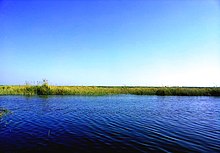
Alexandria is located in the country of Egypt, on the southern coast of the Mediterranean. It is in the Far West Nile delta area.[33] Its a densely populated city, its core areas belie its large administrative area.
| Region | (Population) | Area km2 |
Density per km2 (2020) | |
|---|---|---|---|---|
| 1996 | 2020 proj* | |||
| Alexandria, 14 kisms (contiguous) | 2,199,000 | 4,439,000 | 203.57 | 21,805 |
Notes:2020 CAPMAS projection based on 2017 revised census figures, may differ significantly from 2017 census preliminary tabulations. The 14 kisms were reported simply as Alexandria city by CAPMAS in 2006 but given explosive growth definitions, likely informal, may have changed or may be set to change. Same area with 12 kisms existed in 1996. Kisms are considered 'fully urbanized'[34]
Climateedit
Alexandria has a hot steppe climate (Köppen climate classification: BSh),[35] formerly hot desert climate (Köppen climate classification: BWh).[36] Like the rest of Egypt's northern coast, the prevailing north wind, blowing across the Mediterranean, gives the city a less severe climate than the desert hinterland.[37] Rafah and Alexandria[38] are the wettest places in Egypt; the other wettest places are Rosetta, Baltim, Kafr el-Dawwar, and Mersa Matruh. The city's climate is influenced by the Mediterranean Sea, moderating its temperatures, causing variable rainy winters and moderately hot and slightly prolonged summers that, at times, can be very humid; January and February are the coolest months, with daily maximum temperatures typically ranging from 12 to 18 °C (54 to 64 °F) and minimum temperatures that could reach 5 °C (41 °F).
Alexandria experiences violent storms, rain and sometimes sleet and hail during the cooler months; these events, combined with a poor drainage system, have been responsible for occasional flooding in the city in the past though they rarely occur anymore.[39] July and August are the hottest and driest months of the year, with an average daily maximum temperature of 30 °C (86 °F). The average annual rainfall is around 200 mm (7.9 in) but has been as high as 417 mm (16.4 in)[40]
Port Said, Kosseir, Baltim, Damietta and Alexandria have the least temperature variation in Egypt.
The highest recorded temperature was 45 °C (113 °F) on 30 May 1961, and the coldest recorded temperature was 0 °C (32 °F) on 31 January 1994.[41][42][43][44][45]
| Climate data for Alexandria (El Nouzha Airport) 1991–2020, extremes 1957–present | |||||||||||||
|---|---|---|---|---|---|---|---|---|---|---|---|---|---|
| Month | Jan | Feb | Mar | Apr | May | Jun | Jul | Aug | Sep | Oct | Nov | Dec | Year |
| Record high °C (°F) | 29.6 (85.3) |
33.0 (91.4) |
40.0 (104.0) |
40.8 (105.4) |
45.0 (113.0) |
43.9 (111.0) |
40.7 (105.3) |
39.8 (103.6) |
39.0 (102.2) |
38.3 (100.9) |
35.7 (96.3) |
31.0 (87.8) |
45.0 (113.0) |
| Mean daily maximum °C (°F) | 18.4 (65.1) |
19.0 (66.2) |
21.1 (70.0) |
24.1 (75.4) |
26.9 (80.4) |
29.1 (84.4) |
30.5 (86.9) |
31.0 (87.8) |
30.2 (86.4) |
27.8 (82.0) |
24.0 (75.2) |
20.1 (68.2) |
25.2 (77.4) |
| Daily mean °C (°F) | 14.0 (57.2) |
14.4 (57.9) |
16.4 (61.5) |
19.0 (66.2) |
22.2 (72.0) |
25.2 (77.4) |
27.1 (80.8) |
27.8 (82.0) |
26.4 (79.5) |
23.6 (74.5) |
19.6 (67.3) |
15.6 (60.1) |
20.9 (69.6) |
| Mean daily minimum °C (°F) | 9.5 (49.1) |
9.7 (49.5) |
11.8 (53.2) |
14.3 (57.7) |
17.8 (64.0) |
21.7 (71.1) |
23.9 (75.0) |
24.4 (75.9) |
22.5 (72.5) |
19.3 (66.7) |
15.1 (59.2) |
11.1 (52.0) |
16.8 (62.2) |
| Record low °C (°F) | 1.2 (34.2) |
1.2 (34.2) |
2.3 (36.1) |
3.6 (38.5) |
8.5 (47.3) |
11.6 (52.9) |
17.0 (62.6) |
17.8 (64.0) |
14.0 (57.2) |
10.7 (51.3) |
4.6 (40.3) |
1.2 (34.2) |
1.2 (34.2) |
| Average precipitation mm (inches) | 61.4 (2.42) |
35.2 (1.39) |
12.8 (0.50) |
2.6 (0.10) |
1.0 (0.04) |
0.0 (0.0) |
0.0 (0.0) |
0.0 (0.0) |
0.8 (0.03) |
8.3 (0.33) |
36.8 (1.45) |
52.7 (2.07) |
211.6 (8.33) |
| Average precipitation days (≥ 1.0 mm) | 8.2 | 5.4 | 2.8 | 1.2 | 1.4 | 0.5 | 0.4 | 0.4 | 0.2 | 1.2 | 3.5 | 5.9 | 31.1 |
| Average relative humidity (%) | 69 | 67 | 67 | 65 | 66 | 68 | 71 | 71 | 67 | 68 | 68 | 68 | 67.9 |
| Average dew point °C (°F) | 7.8 (46.0) |
7.8 (46.0) |
9.1 (48.4) |
11.3 (52.3) |
14.4 (57.9) |
17.9 (64.2) |
20.1 (68.2) |
20.4 (68.7) |
18.6 (65.5) |
15.9 (60.6) |
12.6 (54.7) |
9.0 (48.2) |
13.7 (56.7) |
| Mean monthly sunshine hours | 192.0 | 210.3 | 247.0 | 273.9 | 316.8 | 353.2 | 362.2 | 345.3 | 296.7 | 281.7 | 224.1 | 195.7 | 3,298.9 |
| Source 1: NOAA (humidity, dew point, sun 1961–1990)[35][36] | |||||||||||||
| Source 2: Meteo Climat (records)[46] | |||||||||||||

